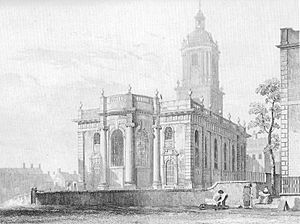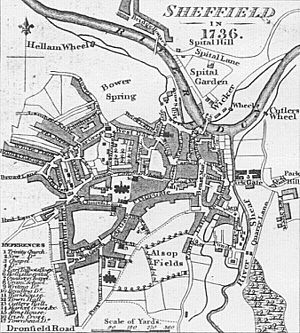St Paul's Church, Sheffield facts for kids
Quick facts for kids St Paul's Church |
|
|---|---|

St Paul's in 1809, as seen by Edward Blore.
|
|
| Religion | |
| Affiliation | Anglican |
| District | Diocese of York (Diocese of Sheffield from 1914) |
| Ecclesiastical or organizational status | Former church |
| Year consecrated | 1740 |
| Location | |
| Location | Sheffield South Yorkshire, England |
| Architecture | |
| Architectural type | Church |
| Completed | 1721 |
| Capacity | 1,200 |
St Paul's Church in Sheffield was once an important church that helped the main Sheffield Parish Church. It was built to serve the growing number of people living in the city.
Contents
Why Sheffield Needed a New Church
Around the year 1700, Sheffield was getting much bigger. About 5,000 people lived there! This meant the main church, Sheffield Parish Church, was becoming too small. More space was needed for everyone who wanted to attend church services.
So, people decided to build a second Anglican church. They chose a spot on the south side of town. This area is now known as Pinstone Street.
Building St Paul's
To pay for the new church, people donated money. This is called a public subscription. Most of the church was finished by 1721.
St Paul's Church was built in the Baroque style. This style often uses grand designs and lots of decoration. The front of the church, facing the street, had a tall tower. This tower looked a bit like buildings you might see in Italy. The church was quite large and could hold up to 1,200 people.
The Long Wait to Open
Even though the church building was mostly ready by 1721, it didn't open until 1740. This was because of a big disagreement.
Who Gets to Choose the Leader?
A local goldsmith named Robert Downes had given a lot of money to build the church. He paid £1,000 and promised another £30 each year. In return, he wanted his family to always have the right to choose the church's minister (the person who leads the services).
However, the Vicar of Sheffield disagreed. He believed that because St Paul's was a "chapel of ease" to his church, he should be the one to choose the minister.
Finding a Solution
The argument went on for a long time. In 1739, Robert Downes became very frustrated. He threatened to open the church for a different group of Christians called Dissenters.
Finally, they found a way to agree. The Vicar of Sheffield would have the right to choose the minister. But, the very first minister would be a relative of Robert Downes. To make this agreement official, a special law was passed by Parliament.
After this, St Paul's Church was officially opened. It was dedicated to Saint Paul on May 22, 1740.
Changes and Updates
Over the years, St Paul's Church saw some additions and changes.
- In 1755, a new organ was installed. It was made by a famous organ builder named John Snetzler.
- A dome was added to the church's tower in 1769.
- In 1824, St Paul's Church became its own separate parish. This meant it was no longer just a "chapel of ease" but a main church for its local area.
- A special memorial was placed in the church around this time. It honored Reverend Alexander Mackenzie and was designed by the famous artist Francis Legatt Chantrey.
Why St Paul's Church Closed
In the 1930s, the area around St Paul's Church changed a lot. Many old buildings were taken down to make way for new developments. Because of these changes, fewer people lived near the church. This meant the number of people attending services at St Paul's became very small.
So, St Paul's Church closed its doors in 1937. It was then taken down the next year, in 1938.
What Happened to the Site and Its Contents?
After the church was demolished, the area became a public space called St Paul's Gardens. Today, these gardens are known as the Peace Gardens in Sheffield city center.
The organ from St Paul's was moved to All Saints Church in Wingerworth. The memorial to Reverend Alexander Mackenzie was also moved. You can now see it at Sheffield Cathedral. Many of the old graves from the church's burial ground were moved to Abbey Lane Cemetery.
Interestingly, some of the stone from the old church was reused. The company that took down the church used the stone to build houses in the western parts of Sheffield. You can still see these stones in some houses today!


